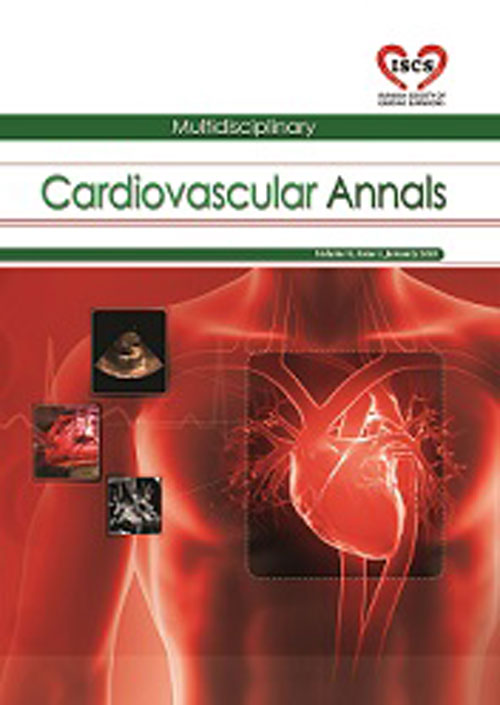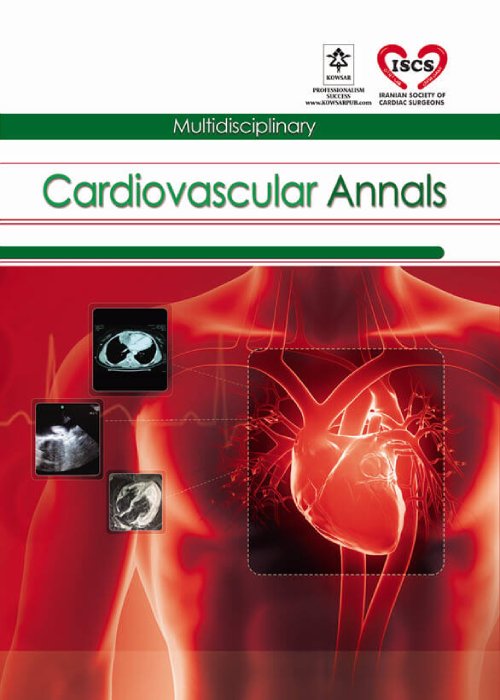فهرست مطالب

Multidisciplinary Cardiovascular Annals
Volume:9 Issue: 1, Jan 2018
- تاریخ انتشار: 1397/02/29
- تعداد عناوین: 5
-
-
Page 1BackgroundElectrolyte abnormalities are common in coronary artery bypass graft surgery (CABG) using cardiopulmonary bypass (CPB). Changes in serum sodium (Na) concentration more than 15 meq/L in perioperative period (Delta Na > 15) is considered as significant fluctuation. The aim of this study was evaluating the relationship between the significant fluctuation of serum Na level and the complications after coronary artery bypass graft surgery.MethodsIn this prospective observational study 59 patients who were candidates for CABG with CPB were enrolled into the study. We recorded patients demographic data, arterial blood gas analysis (ABG), serum electrolytes including Na levels from anesthesia induction, during and after CPB up to 24 hours after admission in ICU. Postoperative complications until discharge from ICU were compared between patients with significant Na fluctuation and those without it.ResultsThirty-nine patients had serum sodium fluctuation equal and more than 15 mEq/L (Delta Na ≥ 15 group). This group was compared with those who had minor Na variation (Delta Na 15 mEq/L fluctuation group had higher serum Na and lactate levels, lower base excess in ABG. Patients with at least one postoperative complication, were older and had lower ejection fraction and more sodium fluctuations. Logistic regression analysis showed that serum sodium fluctuation more than 15mEq/l was independently associated with post CABG complications.ConclusionsPerioperative serum sodium fluctuation more than 15mEq/L was independently associated with postoperative complications in patients undergoing CABG.Keywords: Serum Sodium Level, Complications, Coronary Artery Bypass Surgery
-
Page 2BackgroundPrevention of surgical site infection is the first concern in cardiac surgery. Deep sternal infection causes death in patients and increases the length of hospitalization and the cost of treatment. Several therapeutic protocols have long been used by cardiac surgeons for antimicrobial prophylaxis. The aim of this study is to evaluate the clinical outcomes of prescribing different antibiotic prophylaxis in patients undergoing coronary artery bypass graft surgery.MethodsIn this prospective cross-sectional study, 200 patients with a mean age of 60 ± 9.5 years (145 male, 55 female) undergoing elective isolated coronary artery bypass graft (CABG) were enrolled. Post-operative infections, renal and pulmonary complications, the incidence of mortality, length of stay in ICU and hospital were compared and evaluated based on the type of prophylactic antibiotics.ResultsAmong the studied subjects, 145 patients (72.5%) were males and 55 patients (27.5%) were female. There was no significant relationship between the administration of antibiotic prophylaxis and renal complications, pulmonary complications, wound infections, mortality, and the mean hospitalization time (P = 0.04). Only the association between clindamycin antibody and mortality rate was statistically significant (P = 0.049). The average duration of admission to the ICU in patients receiving cefazolin antibiotics was significantly lower than those who did not receive this antibiotic (P value = 0.04).ConclusionsWe can conclude that the use of different prophylactic antibiotics in isolated CABG patients, according to the physician's personal preference or experience, does not essentially result in better clinical outcomes and less wound complications and infections. Approved protocol for prophylactic antibiotics was only addressed in half of CABG patients.Keywords: Antibiotic Prophylaxis, Prescription Pattern, Coronary Artery Bypass Graft, Clinical Outcome of Antibiotic Use
-
Page 3BackgroundThe purpose of our study was to prove the hypothesis that balloon pulmonary valvuloplasty could effectively reduce valvular gradient ranged 30 to 50 mmHg to less than 30 mmHg in long-term follow-up.MethodsThis cross-sectional study was performed on 271 consecutive patients aged 12 to 67 years who suffered from severe pulmonary stenosis who were scheduled for balloon pulmonary valvuloplasty at Shahid Rajaie Heart Center in Tehran between 2003 and 2013. Two years after the procedure, the patients were examined by transthoracic echocardiography and parameters related to pulmonary valve and right ventricular condition were reassessed. Among all 271 patients who were initially included into the survey, 37 patients (13.7%) had pulmonary valve gradient 30 to 50 mmHg that included our final targeted population for assessment.ResultsValvular gradient significantly dropped down from 93.19 ± 39.77 mmHg to 38.78 ± 26.26 (PConclusionsMajority of patients with moderate pulmonic stenosis with gradient of 30 to 50 mmHg benefit from this procedure to achieve gradient less than 30 mmHg in long-term follow-up.Keywords: Congenital Heart Disease, Pulmonary Stenosis, Balloon Valvuloplasty, Long Term Outcome
-
Page 4IntroductionShone syndrome is a rare congenital anomaly consisting of multiple levels of obstruction in the left side of the heart and aorta. In its complete form it comprises four types of lesions: (1) parachute mitral valve; (2) supravalvular ring of left atrium; (3) subaortic stenosis of either the muscular or membranous type; or (4) coarctation of the aorta. Shone complex is rarely associated with patent ductus arteriosus. Only two other cases of such association has previously been reported.Case PresentationWe report an 18 year old male referred to our center for aortic and mitral valve replacement who was a near complete case of Shone syndrome associated with a history of repaired coarctation and patent ductus arteriosus during infancy and subsequently repair of aortic valve at 3 years of age. Now he became symptomatic due to the progression of aortic stenosis and congenital mitral valve stenosis. Echocardiography revealed unicuspid aortic valve with severe stenosis and parachute mitral valve deformity with supravalvular ring resulting in severe mitral stenosis. The patient had undergone aortic and mitral valve replacements.ConclusionsThis rare case is a near complete form of Shone complex associated with patent ductus arteriosus.It is emphasized that when any form of left heart obstruction is encountered we should meticulously look for other associated lesions.Keywords: Congenital Heart Disease, Shone's Anomaly, Patent Ductus Arteriosus, Mitral Valve Ring
-
Page 5Total anomalous pulmonary venous connection (TAPVC) is referred to a specific condition in which there is no direct connection between any pulmonary veins and the left atrium. In this report, we describe a case of mixed type TAPVC in a newborn. The surgical correction of anomaly was successful. The child had an uneventful post-op recovery and was discharged.Keywords: Pediatric Cardiology, TAPVC, Pulmonary Vein Anomalous, Pediatric Cardiac Surgery


